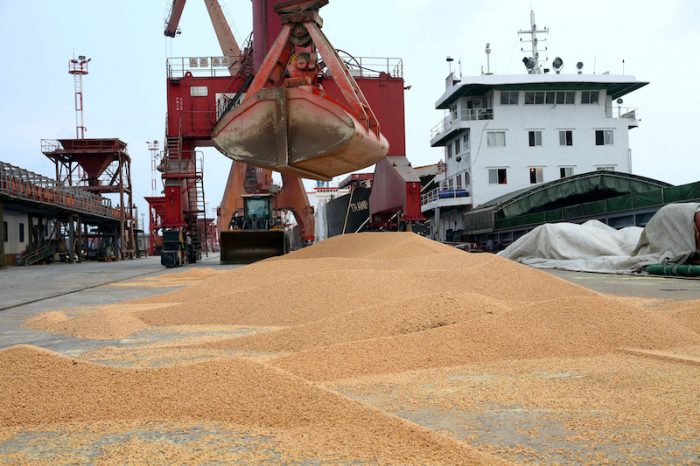China posted a record overall trade surplus in July of more than $101 billion, which was another small rise on the surplus of nearly $98 billion in June, according to the customs data.
Exports rose by 18% last month from a year earlier – the best outcome this year, while imports rose 2.3%.
China’s trade surplus with the United States edged up to $41.51 billion in July, according to calculations on the latest customs data released on Sunday. That was a slim rise from $41.4 billion surplus with the US in June.
Analysts had expected exports to fade amid growing signs of cooling global consumption.
A global factory survey released last week showed demand weakened in July, with orders and output indexes falling to their weakest levels since the onset of the Covid-19 pandemic in early 2020.
China’s official manufacturing survey indicated activity contracted last month, raising fears that the economy’s recovery from widespread lockdowns in spring will be slower and bumpier than expected.
But there were signs that transport and supply chain disruptions caused by the lockdowns were continuing to ease, just in time for shippers preparing for peak year-end shopping demand.
Foreign trade container throughput at eight major Chinese ports rose 14.5% in July, speeding up from the 8.4% gain in June, according to data released by the domestic port association.
Container throughput at Covid-hit Shanghai port hit a record high in July.
ALSO SEE: China Buys Record $17.5bn of US Farm Goods in First Half
Imports Weaker Than Expected
Import growth was weaker than expected, however, suggesting China’s domestic consumption remains soft.
Imports rose 2.3% from a year earlier, compared with June’s 1% gain and missing a forecast of a 3.7% rise.
Analysts have expected import momentum to pick up modestly in the second half of the year, supported by construction-related equipment and commodities as the government ramps up infrastructure spending.
China posted a record $101.26 billion trade surplus last month as a result of the low reading on imports but solid export growth. Analysts had forecast a $90 billion trade surplus.
The country’s top economic planner said last week that the economy is in the “critical window” of stabilisation and recovery, and the third quarter is “vital.”
Top leaders recently signalled they were prepared to miss the government growth target of around 5.5% for 2022, which analysts said had been looking increasingly unattainable after the economy narrowly avoided contracting in the second quarter.
The International Monetary Fund in late July sharply cut its 2022 growth forecast for China to 3.3% from 4.4% in April, citing Covid lockdowns and the worsening crisis in the country’s property sector.
High Prices, Weak Demand Hit Soybean Imports
China’s soybean imports in July fell 9% from a year earlier, the data showed, as poor crushing margins and weaker consumption in the world’s largest buyer of the oilseed reduced appetite for shipments.
China brought in 7.9 million tonnes of the oilseed in July, versus 8.7 million tonnes a year earlier.
These food imports were down 4.5% from a month ago.
Soybean prices have soared this year after bad weather hurt production in and exports from Brazil, China’s top supplier.
Demand from China is also weaker than a year ago as cities like Shenzhen, Shanghai and Wuhan faced mass testing, targeted lockdowns or restrictions to contain the spread of Covid-19.
“Covid lockdowns curbed consumption and negative profits decreased pig inventory” for pig farmers, Rosa Wang, an analyst at agriculture consultancy Shanghai JC Intelligence, said ahead of the data release.
Soybeans are crushed to make soymeal, a key pig feed ingredient, and soyoil for cooking.
“Poor crush margins and high import costs have also dampened crushers’ overseas purchases of soybeans,” Wang explained.
Crush margins in China have been negative since mid-April, with crushers in the key processing hub of Rizhao losing 644 yuan ($95.26) for each tonne of soybean processed as of August 5.
Pig farmers had also been seeing negative margins for the first five months of the year, as pork demand contracted due to repeated Covid outbreaks.
China, the world’s second-largest economy, has a strict zero-Covid policy of eliminating outbreaks as soon as they emerge, resulting in restrictions on movement and targeted lockdowns that stifle consumption and economic activity.
From January to July 2022, China brought in 54.2 million tonnes of the oilseed, down nearly 6% from the same period a year ago, the data showed.
- Reuters with additional editing by Jim Pollard
ALSO SEE:
China Home Sales Plunge in July Amid Mortgage Boycott
China Economy Falters as Factory, Property, Job Woes Mount
























